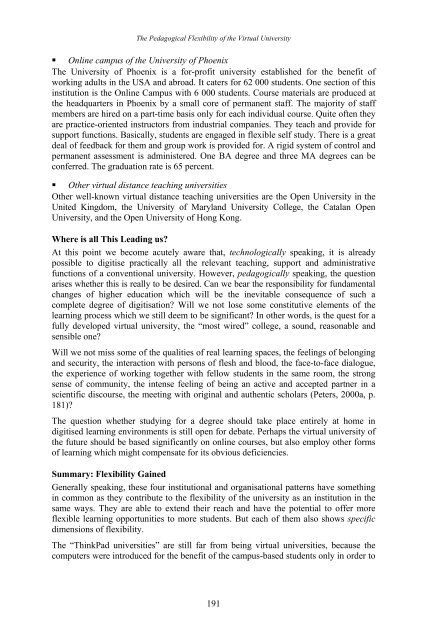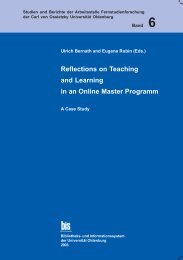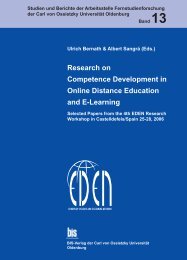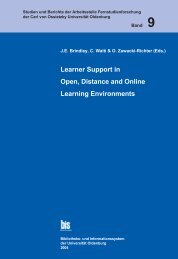Distance Education in Transition - Master of Distance Education ...
Distance Education in Transition - Master of Distance Education ...
Distance Education in Transition - Master of Distance Education ...
Create successful ePaper yourself
Turn your PDF publications into a flip-book with our unique Google optimized e-Paper software.
The Pedagogical Flexibility <strong>of</strong> the Virtual University<br />
� Onl<strong>in</strong>e campus <strong>of</strong> the University <strong>of</strong> Phoenix<br />
The University <strong>of</strong> Phoenix is a for-pr<strong>of</strong>it university established for the benefit <strong>of</strong><br />
work<strong>in</strong>g adults <strong>in</strong> the USA and abroad. It caters for 62 000 students. One section <strong>of</strong> this<br />
<strong>in</strong>stitution is the Onl<strong>in</strong>e Campus with 6 000 students. Course materials are produced at<br />
the headquarters <strong>in</strong> Phoenix by a small core <strong>of</strong> permanent staff. The majority <strong>of</strong> staff<br />
members are hired on a part-time basis only for each <strong>in</strong>dividual course. Quite <strong>of</strong>ten they<br />
are practice-oriented <strong>in</strong>structors from <strong>in</strong>dustrial companies. They teach and provide for<br />
support functions. Basically, students are engaged <strong>in</strong> flexible self study. There is a great<br />
deal <strong>of</strong> feedback for them and group work is provided for. A rigid system <strong>of</strong> control and<br />
permanent assessment is adm<strong>in</strong>istered. One BA degree and three MA degrees can be<br />
conferred. The graduation rate is 65 percent.<br />
� Other virtual distance teach<strong>in</strong>g universities<br />
Other well-known virtual distance teach<strong>in</strong>g universities are the Open University <strong>in</strong> the<br />
United K<strong>in</strong>gdom, the University <strong>of</strong> Maryland University College, the Catalan Open<br />
University, and the Open University <strong>of</strong> Hong Kong.<br />
Where is all This Lead<strong>in</strong>g us?<br />
At this po<strong>in</strong>t we become acutely aware that, technologically speak<strong>in</strong>g, it is already<br />
possible to digitise practically all the relevant teach<strong>in</strong>g, support and adm<strong>in</strong>istrative<br />
functions <strong>of</strong> a conventional university. However, pedagogically speak<strong>in</strong>g, the question<br />
arises whether this is really to be desired. Can we bear the responsibility for fundamental<br />
changes <strong>of</strong> higher education which will be the <strong>in</strong>evitable consequence <strong>of</strong> such a<br />
complete degree <strong>of</strong> digitisation? Will we not lose some constitutive elements <strong>of</strong> the<br />
learn<strong>in</strong>g process which we still deem to be significant? In other words, is the quest for a<br />
fully developed virtual university, the “most wired” college, a sound, reasonable and<br />
sensible one?<br />
Will we not miss some <strong>of</strong> the qualities <strong>of</strong> real learn<strong>in</strong>g spaces, the feel<strong>in</strong>gs <strong>of</strong> belong<strong>in</strong>g<br />
and security, the <strong>in</strong>teraction with persons <strong>of</strong> flesh and blood, the face-to-face dialogue,<br />
the experience <strong>of</strong> work<strong>in</strong>g together with fellow students <strong>in</strong> the same room, the strong<br />
sense <strong>of</strong> community, the <strong>in</strong>tense feel<strong>in</strong>g <strong>of</strong> be<strong>in</strong>g an active and accepted partner <strong>in</strong> a<br />
scientific discourse, the meet<strong>in</strong>g with orig<strong>in</strong>al and authentic scholars (Peters, 2000a, p.<br />
181)?<br />
The question whether study<strong>in</strong>g for a degree should take place entirely at home <strong>in</strong><br />
digitised learn<strong>in</strong>g environments is still open for debate. Perhaps the virtual university <strong>of</strong><br />
the future should be based significantly on onl<strong>in</strong>e courses, but also employ other forms<br />
<strong>of</strong> learn<strong>in</strong>g which might compensate for its obvious deficiencies.<br />
Summary: Flexibility Ga<strong>in</strong>ed<br />
Generally speak<strong>in</strong>g, these four <strong>in</strong>stitutional and organisational patterns have someth<strong>in</strong>g<br />
<strong>in</strong> common as they contribute to the flexibility <strong>of</strong> the university as an <strong>in</strong>stitution <strong>in</strong> the<br />
same ways. They are able to extend their reach and have the potential to <strong>of</strong>fer more<br />
flexible learn<strong>in</strong>g opportunities to more students. But each <strong>of</strong> them also shows specific<br />
dimensions <strong>of</strong> flexibility.<br />
The “Th<strong>in</strong>kPad universities” are still far from be<strong>in</strong>g virtual universities, because the<br />
computers were <strong>in</strong>troduced for the benefit <strong>of</strong> the campus-based students only <strong>in</strong> order to<br />
191





